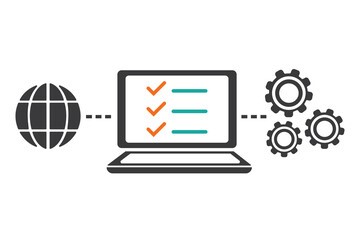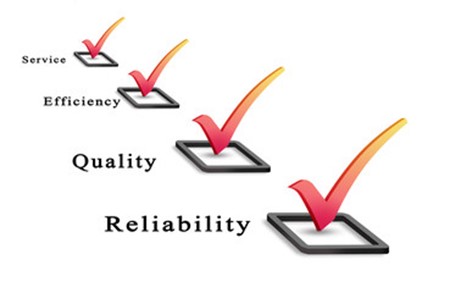For more information on your charming neighborhood CSW Solutions, visit us at our home or subscribe to our newsletter! We also do that social networking thing at: Twitter, Facebook, Linkedin, and Instagram! Check out our #funfactfridays
Metrics of Software Quality & How to Measure it
In an age where businesses must compete technologically, the ability to build high-quality software quickly, efficiently, and economically is key. Unfortunately, most software projects are not successful. If you are looking to build a highly effective software project or company, you can't afford to build something that doesn't measure up. The quality of software is directly proportional to the productivity of the total software development effort and is also a major factor in making business decisions.
As an example, consider the case in which you have two delivery teams consisting of two members each. Team A works on a high-quality code base that has excellent automated test coverage and is developed through a clean code approach with well-designed code. On the other hand, team B develops their application on an existing code base with 60% automated testing coverage, resulting in 350 defects after system testing. The readiness of Team A to deliver becomes obvious from the above example because it has fewer risks due to the high quality of their code base. Quality software allows developers to focus more on their core development tasks rather than fixing issues that can arise due to the low quality of software.
When it comes to software, quality is an incredibly important factor for any business, as it is essential to an efficient and successful operation. Knowing which metrics to use to measure the quality of software is essential for businesses to understand what improvements can be made and how to ensure the best possible outcomes. In this post, we will outline the key metrics of software quality, and provide advice on how to measure them. There are a number of different metrics that can be used to measure the quality of software.

Metrics for Software Quality
Functionality
This measures how well the software performs the tasks it is supposed to. Is it easy to use? Does it do what it is supposed to do? Are there any bugs?
In order for software to be considered quality, it must be functional. This is the most basic of all the different types of quality. Before anything else can be considered, like usability or performance, we need to make sure that the software actually works and perform its main tasks effectively. This is what makes the software usable and ensures that the business case can be met. There are a couple of ways to measure functionality, and they are:
Functionality Metrics of Software Quality:
- Function Point Analysis - This is a functional size measurement methodology. It is based on the idea that software size can be quantified in a way similar to hardware size using function points.
- Scripted Tests - This is a lower-level measurement of software that should be used as a complement to Function Point Analysis. It focuses on individual user tasks instead of the entire scope of the application and captures both positive and negative scenarios.
Usability
This measures how easy the software is to use. Is it intuitive? Are there any confusing or unusable features?
Usability is one of the most important metrics to track when looking at software quality. It's also a bit trickier to measure than others. It's not as simple as counting bugs or testing something until it works. There are a few different usability tests and methods that you can use to track this metric. Try some of the following:
- Human-Computer Interaction (HCI) - These types of tests are formal usability tests. They involve multiple users performing tasks with the software and are video recorded. This data will give you insights into how people use the product, where they struggle, and what they like about it. You can typically hire someone at an agency for $300-$400 per usability test session.
- User Acceptance Testing (UAT) - UAT is typically performed by your customers as they're working within the software, looking for reasons to not use it or problems that might arise from its use.
Reliability
This measures how often the software crashes or experiences errors. Is it stable? Are there any major issues that need to be fixed? Reliability metrics are used to determine the stability of a program. These metrics help you identify flaws and fix them.
The first question that you should ask yourself is, "Is my software reliable?" Aptly named, this metric looks at the number of "bad" events that have taken place during your testing period. A bad event is an error or crash for whatever reason.
In order to calculate a software's reliability, you'll need to record how many bad events happen and how often they occur. This metric can be calculated by dividing the number of bad events by the amount of time it takes to record them. You'll want to track events throughout the entire development process, not just during testing.
Performance
This measures how quickly the software runs. Is it responsive? Is it fast enough for the users’ needs?
Performance is the most easily quantifiable of the software quality metrics. In the case of new enterprise software development projects, the only way to develop a metric is to have a target performance number that you expect to achieve, and then measure everything in terms of meeting or exceeding that expectation. Is the application responsive? Do users understand where they are, and can they easily return to previous screens? Can it be used on a wide variety of devices? Are there speed bottlenecks, and can they be addressed?
In the case of existing software, performance requires a more thorough analysis. Are there quick fixes that can be made to rectify a problem? Are there workarounds available for a commonly-encountered problem? Performance problems are often magnified by poor data architecture, inefficient storage, and failure to scale properly. Software engineers should always be looking for opportunities to improve performance, especially if it has been an issue for users.
Security
This measures how well the software protects data and user information. Is it secure from hacking and other security threats? Security is the most important metric for software quality. While it often goes unmeasured for many reasons, security is the first thing that comes to mind when people list their major concerns when it comes to measuring software quality. Measuring security is difficult because it requires time and skill that many companies don't have on hand.
But how do you measure security? Security is difficult to measure because it's not a fixed feature; it's a constantly changing feature that depends on many factors. With security, you want to try to reduce the risk of data being breached and incorporate a defensive system to cover any points of access that may be vulnerable. A study by IBM X-Force revealed that "67% of backdoor cases were failed ransomware attacks as defenders were able to disrupt the backdoor before the ransomware was deployed." This can be attributed to detailed attention to secure software development at the early stages of development.
Each of these metrics is important in its own way, and businesses should aim to improve all of them. However, which metric is most important will depend on the specific needs of the business. For example, a business that relies heavily on its software for customer-facing tasks will need to focus on functionality and usability, and its software needs to be very stable and reliable will need to focus on reliability. It is recommended that you enlist the help of an industry professional to analyze your software and use metrics like those discussed in this post.
How to Measure Software Quality
Another way to measure the quality of software is to use a combination of different methods, including both quantitative and qualitative data. Quantitative data, such as performance data and error rates, can give you a good overview of how the software is performing. Qualitative data, such as user feedback and surveys, can give you insight into how users are actually finding the software, and what improvements could be made.
The best way to measure the quality of software is to use a combination of different methods, including both quantitative and qualitative data. Both types of data are important, and businesses should aim to collect as much of both as possible. However, it is important to remember that different businesses will have different needs, and so the specific metrics and methods that they use to measure quality will vary. There is no one-size-fits-all solution, so businesses should tailor their approach to their specific needs.
It's important to have metrics in place to help determine if the software being developed or revised is meeting or exceeding these expectations. Our team at CSW Solutions has implemented some of the most widely used testing methodologies including but not limited to:
- Test-driven Development (TDD) where we focus on the development of automated unit tests to verify code correctness. This process encourages a strong emphasis on code quality and documentation.
- Behavior-driven Development (BDD) is a framework that makes it easier for teams to communicate about and understand the requirements, by utilizing a common language.

How to Manage Future Software Quality
One of the best ways to manage future software quality is by following coding standards, code auditing, and refactoring. These are 3 forms of reviewing and maintaining the code base.
If you do not regularly review your code base, it will become harder to maintain it. It will be harder to find bugs, write code or even grow your team later. Refactoring is a way of improving the design of existing code without changing any of its functionality. At CSW Solutions, we believe that quality counts when you build software. We believe the right incentives are critical to building high-quality software. We use a number of metrics in our process, including:
- Best practices and code review
- Automated code testing
- Refactoring and code cleanup
- Code complexity and cyclomatic complexity
- Feature coverage
Software quality metrics and measurement can be a challenging task for many organizations, especially those small businesses with a distributed team. By using the latest techniques and tools, it is easier than ever to ensure you are delivering to your customers in a way that will make them happy, keep your customers longer and increase sales. Quality software is often defined as software that meets the needs of its users, operates within the given constraints, and within the expected time. The expectations for software are that it functions reliably and consistently, has no vulnerabilities or security issues, delivers its functionality, is easy to learn and use, and performs well.
We are a team of experienced enterprise software developers, analysts, designers, and project managers. We have comprehensive expertise in the latest technologies, including cloud, web, mobile applications, web services, and database development services. CSW Solutions provides quality software solutions to businesses by establishing a strategic relationship with our customers, along with the capabilities to produce quality solutions that are highly scalable and cost-effective.

